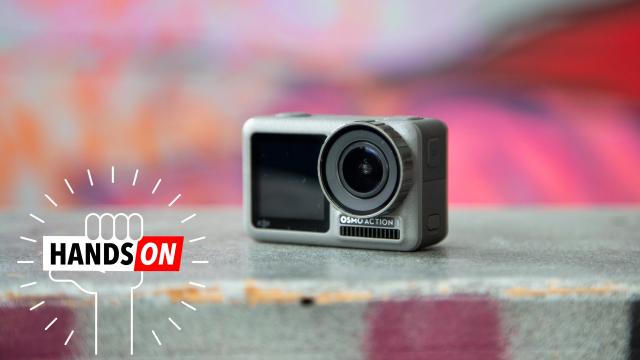GoPro, I have some bad news. Drone giant DJI just released a rugged new camera called the Osmo Action. It’s a lot like a GoPro—so much so that I thought it was a GoPro when my colleague handed it to me. The Osmo Action and the latest GoPro aren’t quite identical, but they’re so similar in size and design that it’s clear how hard DJI is biting GoPro’s style.
The extent to which DJI is taunting GoPro goes beyond the Osmo Action’s looks and into its features. Whereas the Hero7 Black has HyperSmooth image stabilisation, the Osmo Action has RockSteady stabilisation. Both cameras can shoot in 4K at 60fps with their image stabilisation features on or off. Both allow for 8x slow-motion capture. Both are waterproof.. (DJI claims a small victory here, touting 11-meter max depth, while the Hero7 Black claims it’s waterproof up to 10 meters.) They both allow you to snap still images while shooting video. Both have timelapse shooting modes. Both have annoying interfaces made for their small touchscreens that make you want to flip-kick the camera into a wall.
The one big difference between the $499 Osmo Action and, say, a $549 Hero7 Black (or any other GoPro model, for that matter) is the front-facing full-colour display that shows a preview of the video the camera is recording. And it’s going to be a huge selling point for this camera. A significant downside of GoPro’s design has always been the inability to see what you’re recording when trying to film yourself. DJI wisely made the front-facing display a key feature that’s both easy to use and extremely handy while shooting selfie videos. To enable the front-facing display, you just tap the back display with two fingers twice (or hold down the “Quick Switch” button on the side). You do that again to turn it off. Like I said, easy.
If the Osmo Action has a killer feature that the GoPro lacks: That front-facing display is it. It’s also worth noting that, while the Osmo Action is DJI’s first action cam, the company has been in the imaging business for years. DJI has been putting cameras on its consumer drones, since the release of the Phantom FC40 in 2013 and most recently partnered with Hasselblad for the camera on the Mavic 2 Pro. DJI also makes a range of gimbals, including the original Osmo which is essentially an ultra-steady 4K camera that anyone can operate. So the Osmo Action is part of a proven camera-tech legacy. I’m shocked DJI didn’t try to crush GoPro years ago.
The Osmo Action also offers a few bonuses beyond the front colour display. You can shoot 4K HDR video, a helpful feature when shooting in high contrast light. GoPro only offers HDR in the photo and timelapse modes on the Hero7 Black and Hero6 Black. DJI also offers several lens filters—including ND, polarizer, and underwater filters—that screw onto the camera body. GoPro has snap-on filters. In my initial testing, the ND and polarizer filters both worked well and give you some added control over the look of my videos in various lighting conditions and settings. DJI claims that the underwater filters will “restore the natural colour of underwater scenes,” although I haven’t yet had the chance to test out them.
Even in my limited fiddling with the Osmo Action, a few annoying elements became quickly apparent. For one, the image on the camera’s screen lags slightly behind the actual movement of the camera, which is mostly just obnoxious. I do wonder if this quirk could make you miss something while trying to record fast-paced action and only looking through the screen. It’s possible, however, that this lag issue could be something DJI fixes in future firmware updates.
It’s impossible to use the Osmo Action without comparing it to a GoPro, which have defined the action camera space. But that’s not a bad thing! In fact, in DJI’s case, I’d call it shrewd. If you look back a few years, DJI built its business on drones that could make a GoPro airborne. One could argue that it was only a matter of time before DJI itself entered the action cam market.
What’s especially clever is that DJI designed the Osmo Action to work with existing GoPro mounts. That means existing GoPro users don’t have to buy into a whole new accessory ecosystem to enjoy the Osmo Action. The Osmo Action so familiar that the learning curve for GoPro enthusiasts is practically flat.
Ultimately, picking between the Osmo Action and the Hero7 Black may come down to price. The Osmo Action costs $499, while the Hero7 Black retails for about $549 outside of sales.
The Osmo Action begins shipping today in the U.S. and will be available to buy in Australia in June. We’ll have a review of the camera soon.
